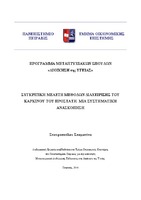Συγκριτική μελέτη μεθόδων διαχείρισης του καρκίνου του προστάτη : μια συστηματική ανασκόπηση
Comparative study of treatment methods on prostate cancer : a systematic review

View/
Keywords
Καρκίνος του προστάτη ; Μέθοδοι θεραπείας ; Ανοικτή ριζική προστατεκτομή ; Λαπαροσκοπική προστατεκτομή ; Ρομποτική προστατεκτομή ; Συγκριτική αξιολόγηση ; Prostate cancer ; Treatment methods ; Open radical prostatectomy ; Laparoscopic prostatectomy ; Robotic prostatectomy ; ComparisonAbstract
The present systematic review attempts to compare the multiple results of different prostate cancer treatments through recent literature. Prostate cancer is the most common type of cancer in Europe followed by lung and colon cancer in second place. The disease is in the second position of causes of death by cancer for male population. There has been an increase of deaths by prostate cancer since 1985 even in countries where this type of cancer used to be quite rare.
Prostate cancer was treated with open surgery traditionally. However, the evolution of biotechnology has changed the facts in surgery and urology the last decade. This evolution came from the latest methods of treatment such as the improvement of lithotriptis, the use of laser technology, the laparoscopic prostatectomy and above all robot assisted laparoscopic prostatectomy with daVinci system.
Robotic prostatectomy provides many advantages as a minimally invasive procedure. First of all there is less pain and blood loss after the whole procedure. There is also no need for transfusion and the patient does not get stressed. The hospital stay is the minimum possible and the recovery is really quick. Last but not least there are no wounds need to be healed. DaVinci system is specialized in specific health conditions and cannot be used in every urologic procedure due to its high cost and its demands in equipment and human expertise.
Robot-assisted prostatectomy and laparoscopic prostatectomy have many things in common. They both represent what is been called “minimally invasive procedures” which are less bloody, less painful perioperatively. They demand the minimum hospital stay and few complications have been noticed. They supposed to be ideal for men in an early age or for older ones if the cancer is localized because they do not affect the functionality (sexual ability, continence). On the other hand the cost of these methods is really high due to the costs of the operating rooms and the costs of the operating supplies. This kind of costs does not exist in the open prostatectomy because the procedure is quicker and there are no special supplies. The open prostatectomy is suitable for non-localized cancers, tumors of great size and high risk type of cancers. In such cases hospital stay is longer, there is important blood loss and marginally lower total costs.


